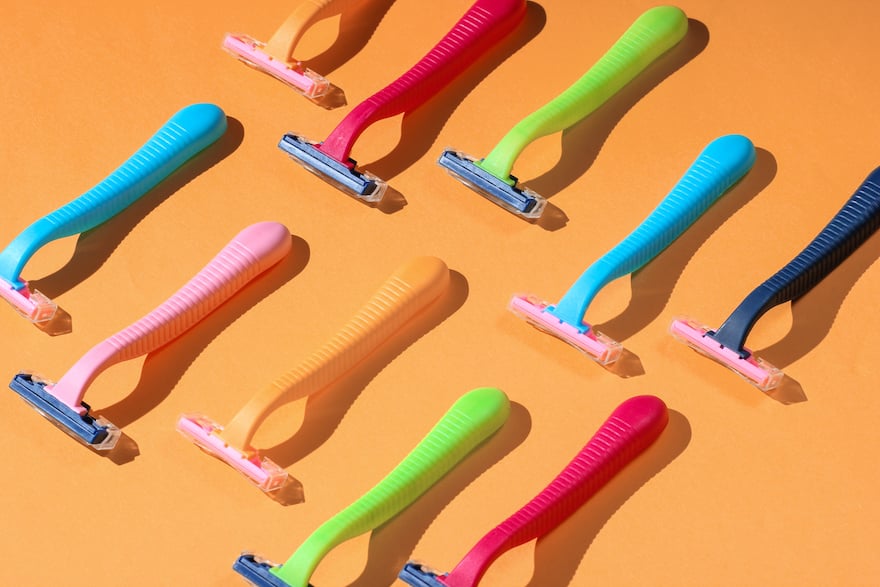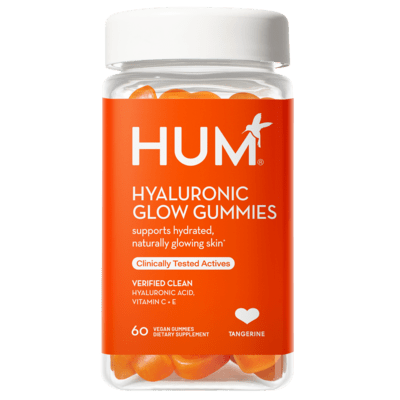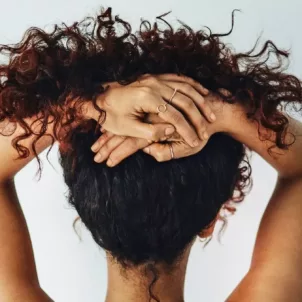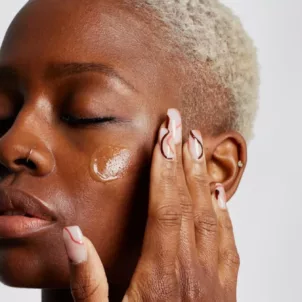So you shaved your bikini line and now you’re dealing with redness and irritation, a.k.a razor bumps. It’s completely normal—and completely treatable. Here, dermatologists break down exactly how to get rid of razor bumps around your bikini area (and how to prevent razor bumps on your bikini line from popping up in the future).
Whether you’re jetting off for a beach getaway or preparing for summertime, for some, swimsuit season can also be bikini razor bump season. You might notice red, irritated bumps (also known as razor burn) or bigger, sensitive red spots (ingrown hairs) after shaving your bikini line. Not only are they annoying, they can also be painful. Luckily, there are ways to treat and prevent bikini razor bumps altogether.
If you prefer to have a hair-free bikini line without the hassle of waxing, we’re here to help. We tapped experts to find out how to get rid of bikini razor bumps (and how to prevent them in the future). Read on to see what they had to say.
What Causes Razor Bumps on the Bikini Line?

Razor burn and bikini bumps are caused by irritation and inflammation of the skin and hair follicles. However, the cause behind the irritation and inflammation can vary. One possibility is contact dermatitis from the metal in your razor, says Caren Campbell, MD, FAAD, a board-certified dermatologist in San Francisco and Napa. “Sometimes it’s also folliculitis, or bacteria in the hair follicle.”
Another likely culprit? Your shaving technique. While it’s tempting to shave against the direction of your hair for a close, smooth shave, it can cause some serious irritation. “Shave in the direction of hair growth instead of against it,” says Campbell. “It’s a less close shave, but you’re less likely to get ingrowns.”
Why Is It More Common to Get Razor Bumps on Your Bikini Line?
If it feels like you’re always getting razor burn or ingrown hairs down there, you’re not alone. The bikini line is a particularly difficult area to shave in general. “Your bikini line is a very sensitive area of the body, and the skin is naturally more prone to irritation,” explains Rachel Nazarian, MD, FAAD, board-certified dermatologist in New York City.
“The groin is more difficult to shave, as the body curvature makes it more difficult to keep the blade appropriately held along the skin surface as you move,” she adds. “Areas where the skin folds on itself, such as armpits or the bikini area, experience more friction forces and rubbing, which can increase risk of razor burn and ingrown bumps.”
The actual hair on your bikini line also plays into the likelihood of bikini bumps. “You have curly, thicker hair in the pubic area, which, when cut flush with the skin, can turn downward and regrow into the skin, causing ‘ingrown hairs,’” Dr. Campbell says.
How to Get Rid of Razor Burn on Your Bikini Line

If you’re experiencing a red, irritated rash, it’s likely razor burn. However, Campbell says there’s a possibility that it’s bacterial growth in the hair follicle, also known as folliculitis. “Washing the area with benzoyl peroxide wash that’s 5 percent or less is best in the shower to help kill the bacteria and unclog the pore,” Campbell says. “You can also get a prescription from your dermatologist or primary care physician for a topical antibiotic like clindamycin, which needs to be used in conjunction with benzoyl peroxide wash to avoid bacterial resistance.”
If it’s just irritation, you need to be gentle with the skin. Avoid shaving again until the razor burn is gone. If it’s itching and irritated, Campbell recommends applying over-the-counter hydrocortisone cream. You can also keep the area calm with aloe vera, oatmeal baths, or an unscented lotion.
How to Get Rid of Ingrown Hairs on Your Bikini Line
If you’re dealing with one (or a few) painful red spots on your bikini line, you likely have ingrown hairs. These occur when the curly hair on your pubic area is cut flush to the skin, curves downward, and grows into the skin instead of out and away.
“To treat an ingrown hair in the bikini line, avoid shaving the area, and avoid tight clothing that can worsen the irritation by rubbing,” Dr. Nazarian says. “Apply warm compresses for two to three days, and apply a topical antibiotic cream mixed with one percent hydrocortisone cream.” The compresses will help soothe irritated spots, help with drainage, and soften the top layer of the skin to help release the ingrown hair.
You can also exfoliate the skin to help release the ingrown hair. Try a chemical exfoliant, like salicylic acid, which will penetrate deeper into the skin to dislodge any buildup. Tempted to try and remove it yourself? It will likely do more harm than good, according to experts. If done incorrectly, tweezing an ingrown hair yourself can cause infection or scarring.
If it’s not getting better, you may be dealing with a more serious case. “If you have a bad ingrown, see your dermatologist for a cortisone injection or surgical removal,” Dr. Campbell advises.
Best Products for Bikini Razor Bumps
Wondering how to get rid of bikini razor bumps? Here are Campbell’s and Nazarian’s top product recommendations.
- Dove Sensitive Skin Beauty Bar, $4
- Jack Black Bump Fix Solution, $27
- Nads Soothing Ingrown Solution, $13
- CCMD Benzoyl Peroxide Wash, $26
- Aveeno Therapeutic Shave Gel, $5
- Schick Quatro Blades, $15
- Fur Ingrown Concentrate, $32
- Pure FIT IPL Laser Treatment, $370
How to Prevent Razor Bumps on Your Bikini Line

So, how do you prevent bikini razor bumps altogether? Follow these expert tips for a smoother shave.
1. Follow the Direction of Your Hair Growth
Both Drs. Campbell and Nazarian agree that you should avoid shaving against your hair growth when it comes to your bikini line. “Ideally, to avoid tugging on the hair, the razor should follow the direction of hair growth while trying to minimize the number of strokes,” Dr. Nazarian says. “Shaving down with hair growth prevents razor burn and ingrown hairs.”
2. Shave at the End of the Shower
Getting a smooth shave is all about prepping the skin appropriately. One of the best things you can do is wait until the end of your shower to shave. “Shaving towards the end of your shower or bath is best—this gives your skin maximum time to soak in the warm water and allows hair to soften, making the shave closer, smoother, and less irritating.”
3. Use a Sharp Blade
The sharper the blades on the razor, the smoother the shave. “Dull blades can tug on hair, while sharp blades glide easily and offer a closer shave,” Dr. Nazarian says. “Since blades tend to dull after a few uses, toss them out by the fourth shave, or even earlier if you see buildup of dirt or dead skin on the blades.” This is especially true if you’re shaving your armpits, where old deodorant can quickly clog the razor. (Word to the wise: Don’t follow up shaving your armpits by shaving your bikini area, as that will only spread the bacteria from this buildup.)
Dr. Nazarian’s pro tip? “Dull blades will irritate sensitive skin quickly—try to keep a separate, clean razor just for the delicate bikini line, and keep it in a dry place when you’re done,” she says.
4. Store Your Razor Outside of the Shower
Yes, it’s convenient to have your razor in the shower—but that may be doing more harm than good. “Do not store the razor in the shower, as it can harbor bacteria,” Dr. Campbell says. Try to store it somewhere dry and away from the shower’s humidity so it doesn’t cause you problems down the line.
5. Use Gentle Products
Step away from scented shaving products. “Using heavily perfumed shaving creams can irritate these delicate skin spots, and they should be substituted with unscented, moisturizing cleansers, preferably not soaps,” Dr. Nazarian says.
Non-soap cleansers include products like Dove Sensitive Skin Body Wash. “They are the best to use in place of traditional shaving creams,” Dr. Nazarian says. “They don’t foam, but will offer a smooth, easy surface for the razor, and prevent over-drying or irritation.”
6. Consider Alternative Grooming Methods
Campbell says one of the best ways to prevent bikini razor bumps is to consider trimming your hair over shaving it. Alternatively, she says laser hair removal is a more permanent and effective solution.
You can get laser hair removal professionally done at a dermatologist’s office (the results are impressively long-lasting), or try it at home with an IPL device (Dr. Nazarian recommends Pure FIT from Smoothskin). “IPL, or intense pulsed light, is the same mechanism that I use in my office to treat patients,” Dr. Nazarian says. “I’ve found it to be one of the most effective ways to permanently remove hair, and minimize ingrown hairs and razor burn.” If you decide to go the at-home route, know that consistency is key for improvement and maintenance of long-term results.
Common Razor Bump FAQs
How to get rid of razor bumps?
To get rid of razor bumps, gently cleanse the area, apply a soothing moisturizer or aloe vera gel, and avoid shaving the affected skin until it heals.
How to get rid of razor bumps overnight?
Use a warm compress to reduce irritation, followed by a topical treatment containing salicylic acid or tea tree oil to soothe inflammation and speed up recovery overnight.
How to prevent razor bumps?
Prevent razor bumps by exfoliating before shaving, using a sharp, clean razor, shaving in the direction of hair growth, and applying a hydrating aftershave.
Razor bump treatment?
Treat razor bumps with calming ingredients like hydrocortisone cream or witch hazel to reduce inflammation, and avoid further irritation by not picking or shaving over the area.
What are the best topical treatments for razor bumps?
The best topical treatments for razor bumps include products with salicylic acid, glycolic acid, or benzoyl peroxide to exfoliate and unclog pores, along with aloe vera or chamomile for soothing relief.









